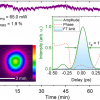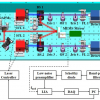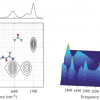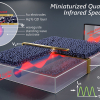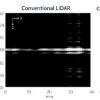
Nanostructures in optical sensing chips may contain nanostructures that are nearly as small as the biological and chemical molecules that are to be detected. These nanostructures improve the sensor’s ability to detect the molecules, but their minute size make it difficult to guide the molecules to the correct area of the sensor.
Scientists at the Center for Integrated Nanotechnologies, Sandia National Laboratories, have created a new sensor for point-of-care applications based on surface-enhanced infrared absorption (SEIRA) spectroscopy that aims to address this size problem. The new sensor consists of several arrays of tiny rectangular strips of gold. Engineers dipped the strips in 1-octadecanethiol, which is a chemical compound (often abbreviated as ODT) that they chose to identify. They then added a drop of liquid metal (in this case, gallium) to serve as the sensor’s base. Lastly, they placed a thin glass cover on top to form a sandwich-like structure.
The design of the sensor, with its layers and cavities, creates what is known as a “nanopatch antenna”. The antenna both funnels molecules into the cavities and absorbs enough infrared light to analyse biological and chemical samples.
“Even a single layer of molecule in our sensor can lead to a 10 % change in the amount of light reflected, whereas a typical sensor may only produce a 1 % change”, says Liu, who adds that the team will continue to refine the sensor with the goal of using it for bioanalytical sensing and medical diagnostics applications, such as sensing biomarkers linked to certain diseases.
After measuring the ODT, the researchers removed the liquid gallium from the sensor chip surface with a swab. This process allows the sensor to be reused, which could make it more cost-effective than similar alternatives.
“The structure of our sensor makes it suitable for point-of-care applications that can be implemented by a nurse on a patient, or even outside the hospital in a patient’s home”, he says.









